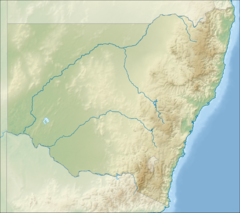Arakoon National Park
| Arakoon National Park | ||
|---|---|---|
| View over Laggers Point from Trial Bay Goal . The breakwater can be seen at the end of the headland. | ||
|
|
||
| Location: | New South Wales , Australia | |
| Specialty: | historical prison building | |
| Surface: | 1.15 km² | |
| Founding: | 2010 | |
The 1.15 km² large Arakoon National Park (English: Arakoon National Park ) is located about 463 kilometers north of Sydney on the coast of New South Wales in Australia . The city of Kempsey is about 40 kilometers to the southwest, the place South West Rocks about four kilometers to the west. It was named after the small suburb of Arakoon of South West Rocks , which borders directly on the national park. In the south the park borders on Hat Head National Park .
History of the park
The importance of this area for human recreation was recognized as early as 1946 when it was declared a Reserve for Public Recreation . This initially affected the Trial Bay Gaol area with the surrounding landscape. It was protected by the state in 1974 as a State Recreation Area . In 1977 Gap Beach was added , Front Beach in 1979 and Saltwater Lagoon in 1983 . In 2010 the state declared the entire area a national park .
geology
On the Smoky Cape in the National Park there is a granite deposit that was used to build a breakwater and a prison. This is the only occurrence of granite to surface between Bundaberg in Queensland and Moruya Heads in southern News South Wales.
The so-called Kempsey Beds are deposits that have pressed together to form greywacke , siltstone and conglomerate rock . They were used to build the prison wall. These rocks date from the Permian period . The sands of the beach and the dunes as well as the deposits of the alluvial soils , the alluvial landscapes, originate from the Quaternary .
Flora and fauna
In the national park there are different groups of vegetation in very small areas. Most of the Smoky Cape Range is covered by hard- leaf vegetation . Coastal rainforest vegetation exists on the dunes behind Gap Beach and near the beach in the north of the headland. Because of the agricultural and tourist development, these forms of growth have nowhere else to be found in the park. Significant wetlands surrounded by saltwater areas lie behind Gap Beach and on the small creek behind Little Bay . The remaining vegetation consists of light forest, heathland and dune vegetation .
Animals that have been observed in the park are brushland ( Trichosurus vulpecula ), short-headed glider ( Petaurus breviceps ), fruit bat ( Pteropus sp. ), Swamp wallaby ( Wallabia bicolor ), marsupial mice (Antechinussp.) And 35 species of birds. Foxes, cats and rats brought in by the Europeans threaten the wildlife in the park.
Trial Bay Gaol

The bay was named after the Trial ship that convicts stole in Sydney in 1816. Their attempt to escape failed when the ship sank in this bay.
The Trial Bay Gaol was had a prison built by the convicts. It is on a headland called Laggers Point . The prisoners could only be accommodated in the prison building after a construction period of 13 years in 1886. To protect ships that could not safely anchor in the mouth of the Macleay River, they were supposed to build a 1,500-meter-long breakwater from blocks of granite that they quarried in a nearby quarry . When about 300 meters of the breakwater were completed, the river shifted its course and no longer flowed into the bay. This made the construction of the breakwater obsolete and the prison was abandoned in 1903.
During World War I , the prison served as an internment camp for captured officers of the Imperial Navy and for Germans and Austrians who lived in Australia and who were believed to sympathize with the war opponents. In 1918 the internees were relocated because it was feared that German warships would land.
Today the prison structure is in ruins, about 50 meters from the breakwater are left. In the historic prison there is now a museum with sculptures on the outer walls.
tourism
There are several hiking trails in the park, a kiosk and restaurant, overnight accommodation in a small cottage and a campsite on Trial Bay . The Trial Bay is popular with tourists for relaxation and swimming and water sports. There is also a boat dock.
Web links
- Official site of the National Park (English)
Individual evidence
- ↑ a b Australian Government - CAPAD 2014 - NSW summary . Terrestrial Protected Areas in New South Wales (2014). DSEWPaC , accessed on August 27, 2017 (English; MS Excel ; 180 kB)
- ↑ a b c Arakoon State Recreation Area. Plan of Management , September 1987, Sydney, at environment.nsw.goa.au. Retrieved August 29, 2017
- ↑ a b Trial Bay, South West Rcoks Detention Barracks 1914-1918 , on auspostalhistory.com. Retrieved August 26, 2017
- ↑ Liz Keen: The history of a gaol , on open.abc.net.au. Retrieved August 25, 2017
- ↑ Arakoon National Park , on nationalparks.nw.gov.au. Retrieved August 25, 2017
- ↑ Trial Bay Goal , on nationalparks.nw.gov.au. Retrieved August 25, 2017


